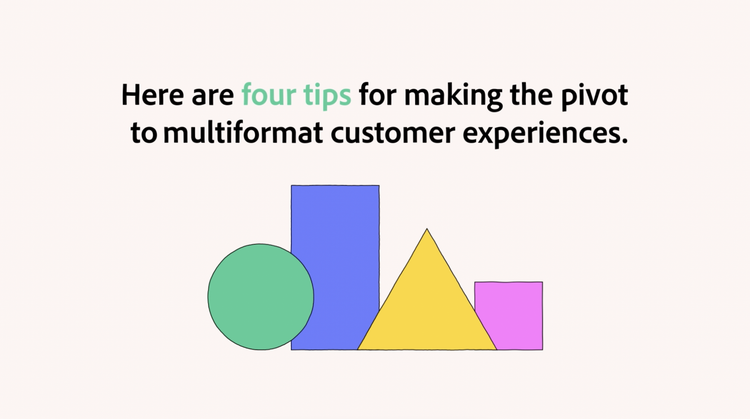Pivoting your creative team to multiformat experiences.
Your customers are everywhere — your content needs to be too.
“But what about TikTok?” your client asks. One of their competitors is all over TikTok and Clubhouse. They’re also soliciting user-generated content from customers actually using the product in their day-to-day. It’s part of a gamified experience designed to boost engagement.
So, your client wonders, how can those assets — some really dynamic and some not-so-great — be integrated into your upcoming social creative? And how do all these pieces come together in your new product landing page and upcoming email series? Suddenly, you realize your social campaign doesn’t seem so platform-ready — and customer expectations have shifted more than you thought.
Your customers are everywhere.
If the standards for digital creative excellence were sky-high before, today they’re off the charts — and that’s impacting creative teams of every size and scope in every industry. But for small and mid-sized creative teams, this need to touch every customer on every platform can be a particularly big ask.
“Digital experiences are following a similar trend that we saw in marketing and branded communications,” says Mark Ramel, principal and creative director at Brooklyn-based Armchair Studio. “At one point, creative campaigns offered a simple message and we interrupted people to deliver that message. Now experiences have become more permission- and entertainment-based — you respect that people’s attention and experiences are more participatory and collaborative.”
To deliver these experiences, he says, individual creatives, as well as small and mid-sized agencies, must be laser-focused on conceptualizing and delivering deep, intuitive customer experiences.
“Each touchpoint in a customer’s journey has to connect. The brand or brands you support need to deliver paths based on who those customers are and what they want from that particular experience,” Mark says. “And each moment needs to connect so we can deliver digital-first, multiformat experiences — experiences that consider channel, message, desired customer experience, and timing.”

“Minimally, customers expect their digital experiences to be connected, seamless, and to keep them from feeling nervous or uncomfortable.”
Drew Milton Associate Creative Director, Adobe
Assess your current creative reach.
Again, keeping consistent interactions with customers at every touchpoint is a big ask for small and mid-sized creative teams. But, by understanding the stakes, keeping an eye on what’s next, and assessing what your team needs to meet those experience objectives, small creative teams can deliver, even with limited resources.
The first step: recognizing what’s table stakes and understanding quickly-emerging customer expectations.
“Minimally, customers expect their digital experiences to be connected, seamless, and to keep them from feeling nervous or uncomfortable,” says Drew Milton, associate creative director at Adobe. “Some really dynamic customer experiences are just table stakes now, especially when it comes to digital advertising. A good example: if you buy an item online and later, you see an ad for that same item, it’s easy to feel disconnected from the brand because it isn’t lending value — or even keeping pace.

“If creatives don’t have the ability to experiment and try different things because they’re feeling like they’re just following a set schedule and map, that can be bad from a customer experience perspective.”
Mark Ramel Principal and Creative Director, Armchair Studio
Understand what you have to work with — and what you can do with it.
We’re in a period of rapid digital transformation, and keeping an eye on emerging customer expectations is critical to keeping pace.
“During the pandemic, customers became more comfortable with diverse, high-stakes digital experiences,” says Drew. “People are willing to share more and do more. They’re more comfortable applying for a loan online when, before COVID, they would have gone to the bank. They’re Zooming with their doctor. They’re grocery shopping online. Most people haven’t done these things before, and they’re becoming a gateway to customers seeking out more and more sophisticated digital experiences.”
Paying attention to what people are doing online helps you understand the level of dynamic touchpoints your audience experiences on a daily basis. From there, it’s easier to put your own deliverables through that lens — and understand what’s preventing your team from delivering the experiences your customers want, need, and expect.
For most smaller creative teams, the greatest gaps are in the ecosystem of tools that link platforms. Ideally, your team has an integrated creative ecosystem that includes cohesive templates and libraries, stores assets, and allows you to easily manage permissions across different user types. Having a good ecosystem also means having the right team in place.
“Organizations need the right tools. They also need the right people using those tools,” Drew says. “For me, that means having a team whose skills complement each other — people being able to fill in each other’s gaps. I want a team with diverse backgrounds and experiences. That makes the work better because you’re tapping into different points of view — not people who have all done the exact same thing and come to the table with the exact same perspectives.”
Put yourself in the customer journey.
With the right tools and talent in place, you can step back and look at the whole customer journey, and figure out how to better serve your clients’ customers at each step.
“Ultimately, creative teams — no matter your size or scope — need to get physical and digital assets to work together,” says Mark. “Right now, that means consistent design, repurposing content for new channels, and creating purposeful assets that send customers between channels.”
That also means wrapping your team’s collective head around user experience (UX). “When we talk about UX, people get nervous — but it’s not a big ask,” Mark says. “We all spend hours and hours a day on our phones and our laptops and our watches. For creatives, it’s about bringing that customer perspective to your work and understanding it so you can map out what a journey could look like, from a creative standpoint.”
Another way smaller teams can accomplish this: spend time looking at the marketing materials being served to you every day. As a customer or prospect, what turns you off? From that vantage point, it’s easy to spot bumps in the road or ways brands aren’t connecting platforms or touchpoints. You can also quickly see when digital channels were treated as secondary experiences and how, in your own work, you can bridge those gaps.
By taking a few simple but strategically important steps, you can shift your team’s mindset and their work to build out digital-led, multiformat customer experiences. But don’t stop there — even smaller creative teams need to keep testing and optimizing.
“If creatives don’t have the ability to experiment and try different things because they’re feeling like they’re just following a set schedule and map, that can be bad from a customer experience perspective,” Mark says. “On the other hand, if you have a bunch of disparate plans and they don’t connect, that’s a bad place as well. Delivering the right kind of customer experiences means changing the way teams collaborate and think about what’s next.”

Adobe can help.
Adobe Creative Cloud for teams gives you the world’s best creative apps and services in a single, secure, integrated platform. With 20+ desktop and mobile apps, Creative Cloud Libraries for keeping assets in sync across apps and devices, and 1TB of storage per user, this complete creativity solution is designed to support your business at every stage of growth. Plus, you can count on simplified license management and total control over your software to help your team stay focused on creating great work.
